Operation "Spark". To the 75 anniversary of the breakthrough of the blockade of Leningrad
General situation in the Leningrad direction
By the beginning of 1943, the situation of Leningrad surrounded by German troops remained extremely difficult. The troops of the Leningrad Front and the Baltic Fleet were isolated from the rest of the Red Army. Attempts to deblokade of Leningrad in 1942 year - Luban and Sinyavinskaya offensive operations were not successful. The shortest path between the Leningrad and Volkhov fronts - between the southern coast of Lake Ladoga and the village of Mga (the so-called Schlesselburg-Sinyavino ledge, 12-16 km), still occupied parts of the 18 of the German army.
On the streets and squares of the second capital of the Union, shells and bombs continued to burst, people died, buildings collapsed. The city was under constant threat of air raids and shelling. The city by November - December 1942 was severely depopulated. As a result of mass mortality, evacuation and additional conscription to the army, the population of Leningrad in one year decreased by 2 million and amounted to 650 thousand people. The overwhelming majority of the remaining population was employed in various jobs. The lack of land communication with the territory under the control of the Soviet troops caused great difficulties in the supply of fuel and raw materials for factories, did not allow to fully meet the needs of troops and the civilian population in food and essential items.
However, the position of Leningrad in the winter 1942-1943. it was still much better than the previous winter. A part of Leningraders even received an increased food ration than in the all-Union. Electricity from the Volkhovskaya HPP was supplied to the city through the cable laid under water in the fall, and fuel via the underwater pipeline. The city was supplied with necessary products and goods on the ice of the lake - “The Road of Life” which resumed work in December. In addition, in addition to the highway, an 35-kilometer-long iron line was constructed directly on the ice of Lake Ladoga. Day and night, there was a continuous blockage of multi-meter piles, which were installed every two meters.
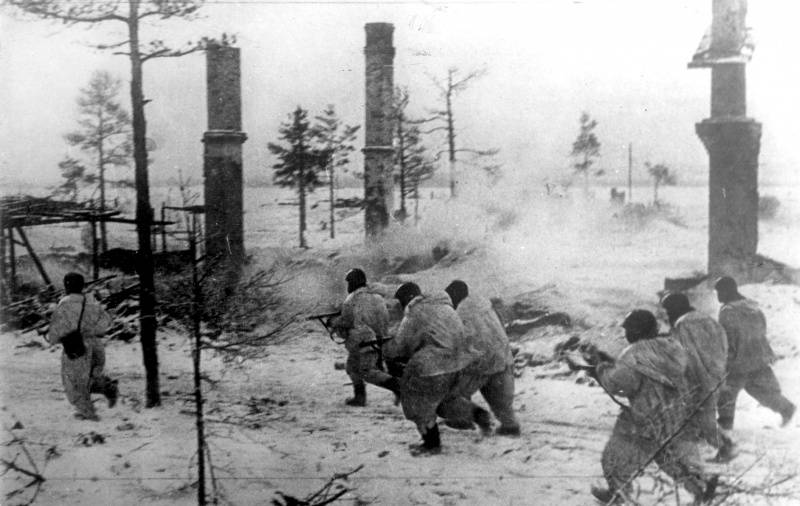
Fighters of the Volkhov front in the offensive during the breaking of the blockade of Leningrad
The forces of the parties
THE USSR. The troops of the Leningrad and Volkhov fronts were involved in the operation, part of the Baltic forces fleet и aviation long range. By the end of 1942, the Leningrad Front under the leadership of Leonid Govorov included: 67th Army - Lieutenant-General Mikhail Dukhanov, 55th Army - Lieutenant-General Vladimir Sviridov, 23rd Army - Major General Alexander Cherepanov, 42- I am the army - Lieutenant General Ivan Nikolaev, Primorsky Task Force and the 13th Air Army - Colonel General Stepan Rybalchenko.
The main forces of LF - 42-I, 55-I and 67-I armies, defended at the turn of Uritsk, Pushkin, south of Kolpino, Porogi, the right bank of the Neva to Lake Ladoga. The 67 Army operated in the 30 km strip along the right bank of the Neva from Porogi to Lake Ladoga, with a small bridgehead on the left bank of the river, in the Moscow Dubrovka region. 55-I infantry brigade of the army from the south defended the highway, which ran on the ice of Lake Ladoga. 23-I army defended the northern approaches to Leningrad, located on the Karelian Isthmus. It should be noted that the situation on this front was stable for a long time, there was even a soldier's saying: "Three (or" there are three neutral ") armies do not fight in the world - the Swedish, Turkish and 23-I Soviet." Therefore, the units of this army were often transferred to other, more dangerous areas. 42-I army defended Pulkovo line. The Primorsk operative group (PRG) was located on the Oranienbaum bridgehead.
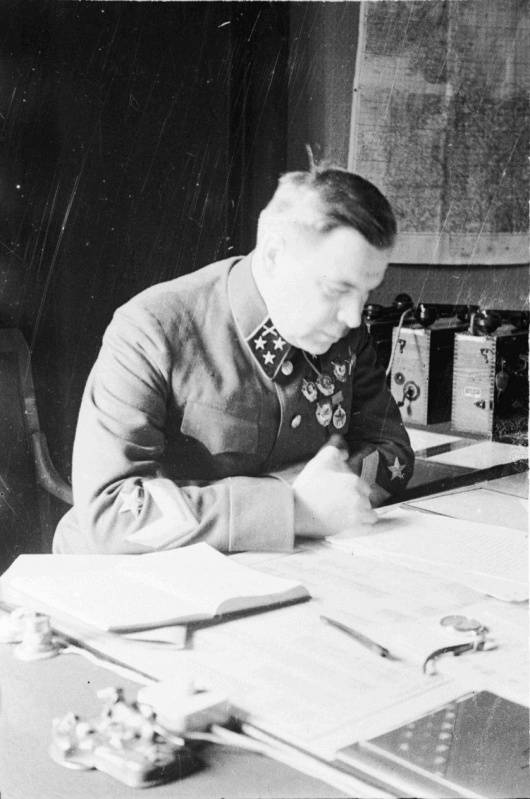
Lieutenant-General of Artillery Leonid Aleksandrovich Govorov at his desk. Leningrad front
LF's actions were supported by the Red Banner Baltic Fleet under the command of Vice Admiral Vladimir Tributs, who was based at the mouth of the Neva River and in Kronstadt. He covered the coastal flanks of the front, supported the ground forces with his aircraft and the fire of ship artillery. In addition, the fleet held a number of islands in the eastern part of the Gulf of Finland, which covered the western approaches to the city. Leningrad also supported the Ladoga Navy. The air defense of Leningrad was carried out by the Leningrad Air Defense Army, which cooperated with the air force and anti-aircraft artillery of the front and fleet. The military motorway on the ice of the lake and the transshipment bases on its shores covered the separate Ladoga air defense region from the Luftwaffe attacks.
The troops of the Leningrad front were separated from the troops of the Volkhov front by the 15-kilometer corridor of the Schlisselburg-Sinyavino ledge, which closed the land blockade of Leningrad. The Volkhov front under the command of Army General Kirill Meretsky at the beginning of 1943 included: 2-I shock army, 4-I, 8-I, 52-I, 54-I, 59-I armies and 14-I air army. But they took direct part in the operation: 2-I attack army - under the command of Lieutenant-General Vladimir Romanovsky, 54-I army - Lieutenant-General Alexander Sukhomlyn, 8-I army - Lieutenant-General Philip Starikov, 14-I air force - General Lt. Aviation Ivan Zhuravlev. They operated in the 300 km lane from Lake Ladoga to Lake Ilmen. On the right flank of Lake Ladoga to the Kirov Railroad were part of the 2 th shock and 8 th armies.
For the offensive, shock groups of the Leningrad and Volkhov fronts were formed, which were significantly strengthened by artillery, tank and engineering units, including from the reserve of the Supreme Command Headquarters. In total, the shock groups of the two fronts totaled 302 soldiers and officers, about 800 guns and mortars (4900 mm caliber and above), more than 76 tanks and 600 aircraft.
Germany
The German high command, after the failure of attempts to take the city, was forced to stop the futile offensive and give the troops the order to go to the defense. All attention was riveted on bleeding, turned into ruins, but not surrendering to Stalingrad. In the autumn of 1942, out of Army Group North, an outflow of troops to the Stalingrad sector began. The 8 th Air Corps was transferred to the Stalingrad region. Manstein, who had previously taken Leningrad, left with his headquarters. From the 18 of the German army, the 12 tank, 20 motorized and several infantry divisions were taken. In return, the 18 Army received the 69 Infantry, 1, 9, and 10 airfield divisions.
The formation of airfield divisions, due to heavy losses in ground forces, began on the initiative of Goering in September 1942 of the year. The airfield divisions did not have a regimental level and consisted of 4 rifle battalions and an artillery battalion, were recruited by personnel of ground services of the Air Force and antiaircraft artillery who had no experience of combined arms combat. They had different weapons, including the Soviet trophy. Thus, the German grouping near Leningrad decreased not only quantitatively, but also deteriorated in terms of quality.
The Red Army was opposed by the 18-I German army under the command of Georg Lindemann (Lindemann), which was part of Army Group North. It consisted of 4 army corps and up to 26 divisions. German troops supported the 1-th Air Fleet of Colonel-General Alfred Keller. In addition, in the northwestern approaches to the city opposite the 23 of the Soviet army, there were 4 Finnish divisions from the Karelian Isthmus task force.
The Germans had the most powerful defense and dense grouping of troops in the most dangerous direction - the Schselselburg-Sinyavino junction (its depth did not exceed 15 km). Here, between the city of Mga and Lake Ladoga, 5 of German divisions was stationed - the main forces of 26 and part of the divisions of 54 of army corps. They included about 60 thousand people, 700 guns and mortars, about 50 tanks and SPG. In the operational reserve were 4 divisions.
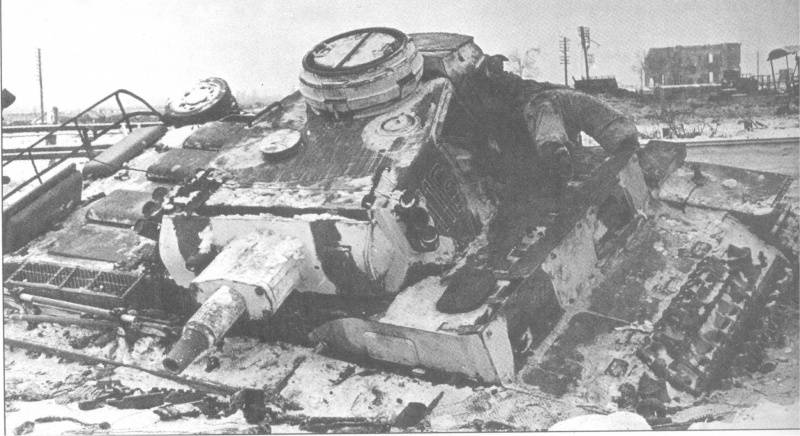
Tank Pz.Kpfw. III Ausf. N, the 116 tactical number from the 1 Company of the 502 Second Detached Battalion of Wehrmacht Heavy Tanks, shot down in the Sinyavin area from January 12 to February 5 1943
Each village was turned into a stronghold, prepared for a perimeter defense, the positions were covered with minefields, wire obstacles and fortified with pillboxes. From the side of Leningrad, the 328 Infantry Regiment of the 227 Infantry Division, General Von Scotty, 170 Infantry Division, General Zander, in full force and the 100th Regiment of the 5th Mountain Rifle Division, who had before the 30 divisions, before the 400 Division, kept the 12 Infantry Regiment. guns. The defensive line of the Germans passed along the left bank of the Neva, whose height reaches 8 meters. The coast was artificially icy, well mined, almost had no convenient natural exits. The Germans had two powerful nodes of resistance. One of them is the construction of the 1-th hydroelectric power station, brick houses of the 2-th and 10-th towns; the second is the numerous stone buildings of Shlisselburg and its outskirts. For each kilometer of the front, there were 12 — 30 bunkers and up to XNUMX guns and mortars, and along the entire bank of the Neva stretched trenches of a complete profile.
The middle defensive line passed through the workers' settlements No. 1 and No. 5, the stations Podgornaya, Sinyavino, the working village No. 6, the village Mikhailovsky. Here there were two lines of trenches, the Sinyavino center of resistance, cut-off positions, and also strong points. The enemy used destroyed Soviet tanks, turning them into fixed firing points. They edged the Sinyavino heights - approaches, the bottom and western slopes, as well as the Roundwood grove. From the Sinyavinsky heights, the southern coast of Lake Ladoga, Shlisselburg, the 8-I hydroelectric power station and the workers' settlement number 5 were clearly visible. This milestone was the position of divisional reserves (up to one regiment) of the German group. All the space was under flank fire from neighboring strongholds and resistance nodes. As a result, the entire ledge resembled one fortified area.
The 227 Infantry Division (without one regiment), the 1 Infantry Division, the 374 Regiment of the 207 Security Division and the 425 Regiment of the 223 Infantry Division defended the two armies of the Volkhov Front. The enemy’s defensive line passed from the village of Lipka through the workers' settlement No. 8, the Kruglaya grove, Gaitolovo, Mishino, Voronovo and further south. At the forefront of the defense, there was a continuous trench, covered with minefields, ridges and wire barriers, in some areas a second trench was also opened. Where the marshland did not allow to go deeper into the ground, the Germans erected icy and loose ramparts, set up two-row log fences. Lipka, the workers' settlement number 8, the Round Grove, the villages of Gaitolovo and Tortolovo were turned into especially powerful centers of resistance.
The situation for the attacking side was exacerbated by the woodland and marshland in the area. In addition, there was a large area of Sinyavino peat deposits, which were cut by deep ditches and additionally fortified with timber, peat, and ice walls. The territory was impassable for armored vehicles and heavy artillery, and they were needed to destroy the enemy fortifications. To overcome such a defense, powerful means of suppression and destruction, a tremendous strain of the forces and means of the attacking side were required.
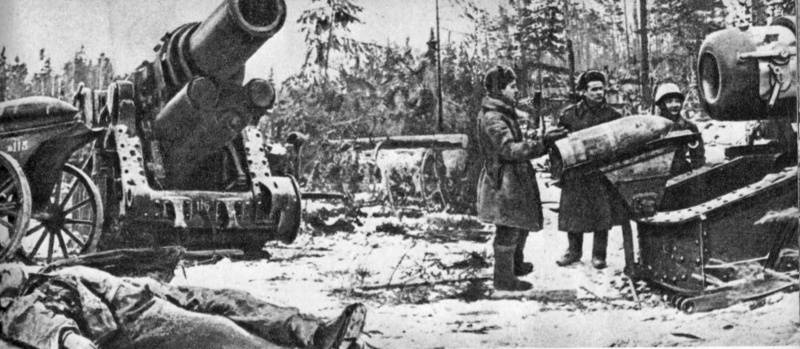
Soviet officers inspect the heavy German guns that shelled Leningrad. These are two 305-mm mortars M16 of Czech production company "Skoda"
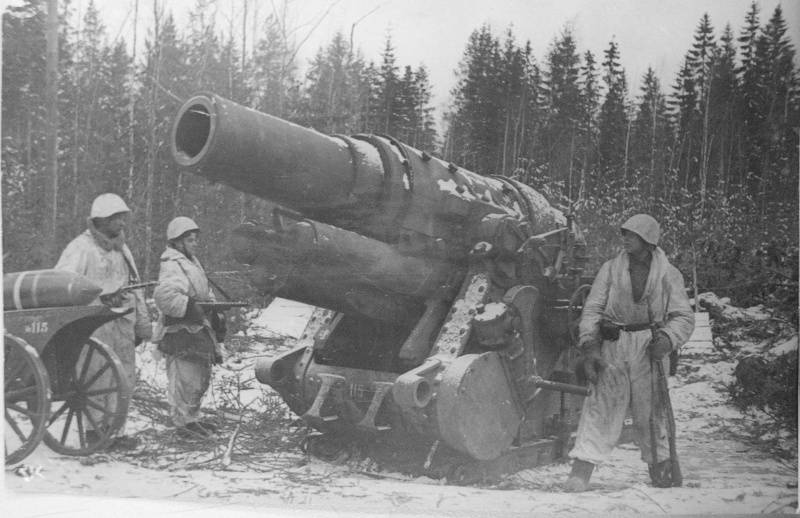
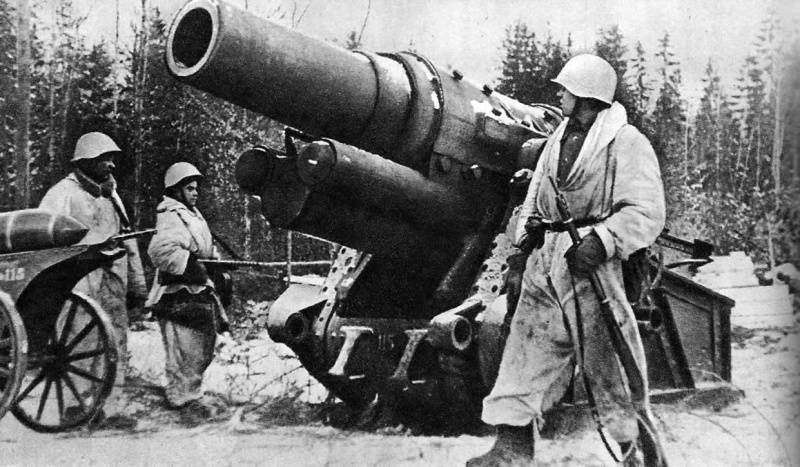
Heavy 305-mm mortar M16 Czech production, captured by Soviet soldiers. Leningrad District
Operation plan
More 18 in November 1942. LF Commander General Govorov sent a report to the Supreme Command Headquarters, proposing to conduct two operations east and west of Leningrad - Shlisselburgskaya and Uritskaya in order to “lift the blockade of Leningrad, ensure the construction of the railway along the Ladoga Canal and thereby organize a normal message Leningrad with the country, ensuring the freedom of maneuver of the troops "of the Leningrad and Volkhov fronts. Having considered this proposal, the bid demanded to focus all attention on the breakthrough of the German defense only in one direction - Schlesselburg, which in the shortest possible way led to the achievement of the set goal.
On November 22, the LF Commander submitted to the BET an updated plan of operation. He envisaged the application of counter attacks - Leningradsky from the west, Volkhovsky - from the east in the general direction of Sinyavino. The December 2 bid approved the submitted plan. The coordination of the actions of both fronts was entrusted to Marshal of the Soviet Union K.E. Voroshilov. They planned to prepare the operation for 1 in January 1943. Specific tasks for the troops of the Leningrad and Volkhov fronts were defined in Directive No. 170703. Headquarters of the Supreme Command from 8 in December 1942. She demanded that by joint efforts of the two fronts, defeat the enemy grouping in the Lipka, Gaitolovo, Moscow Dubrovka, Shlissel regions. thus, “break the siege of the mountains. Leningrad, by the end of January 1943, the operation is to finish. " After that, going to a solid defense at the turn of the river. Sink, pos. Mikhailovsky, Tortolovo, provide communications of the Leningrad Front and give troops 10-day rest. In the first half of February, 1943 was ordered to prepare and conduct an operation to crush the enemy in the Mga area and cleanse the Kirov railway with access to the Voronovo, Sigolovo, Voytolovo, Voskresenskoe lines.
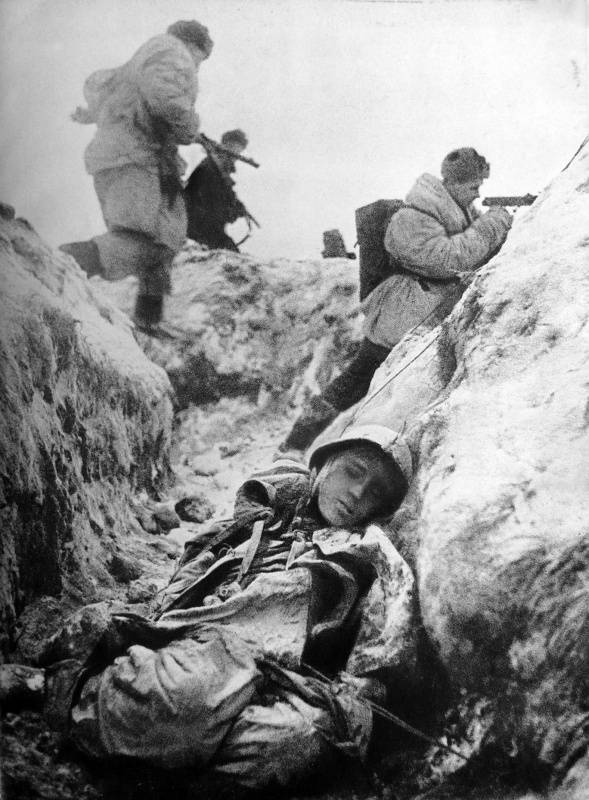
Soviet soldiers in the attack near Leningrad during the beginning of the blockade breaking
Preparation of the operation
For the operation, two strike groups were formed: on the VF - the 2-I attack army of Lieutenant-General V.Z. Romanovsky, on the Leningradsky-67-I army of Major General MP P. Dukhanov. The LF strike grouping had to force the Neva on ice, break through the defenses on the Moscow Dubrovka, Shlisselburg section, defeat the enemy who had dug in here, connect with the HF troops and re-establish communication between Leningrad and the mainland. In the future, planned to yield compounds 67-th army at the line of the river. Wash. The strike force of the VF was supposed to break through the defenses at Lipka, Gaitolovo (width 12 km) and, delivering the main attack on Sinyavino, seize the border, Workers Settlement No. 1, Sinyavino, defeat the Sinyavin-Schlüsselburg enemy grouping and enter the connection with the LF troops. The provision of the left flank of the 2 shock army was entrusted to General F.N. 8 Army. Starikova, which by its right-flank formations was supposed to attack in the direction of Tortolovo, pos. Mikhailovsky. The aviation support and cover of the troops was carried out by the 13 and 14 airborne armies of the Leningrad and Volkhov fronts and the aircraft of the Baltic Fleet (about 900 aircraft in total). Long-range aviation, coastal and naval artillery of the fleet (88 guns) were also involved in the operation.
The operation of the shock group of the Volkhov Front, by decision of the Supreme Command Headquarters, was assigned to the commander of the 2 shock army under the direct supervision of the deputy front commander, Lieutenant General I.I. Fedyuninsky. The operation of the strike group of the Leningrad Front was to be carried out by the commander of the 67 Army under the direct supervision of the front commander, Lieutenant General L.А. Govorova. Representatives of the Supreme Command Headquarters to coordinate the actions of the Leningrad and Volkhov fronts were marshals G. K. Zhukov and K. E. Voroshilov.
The basis of the LF strike group was the 67 Army, built before the offensive in two echelons. The first echelon consisted of 45-th Guards, 268-th, 136-th, 86-th rifle divisions, 61-th tank brigade, 86-th and 118-th individual tank battalions. The second echelon consisted of 13-I, 123-I infantry divisions, 102-I, 123-I, 142-I infantry brigades, and the army reserve - 152-I and 220-I tank brigades, 46-I infantry division, 11-I , 55-I, 138-I rifle, 34-I and 35-I ski brigade. The offensive was supported by the artillery of the army, the front, and the Baltic fleet — only about 1900 guns and mortars and the 13 airborne army with 414 aircraft.
The shock grouping of the Volkhov Front was made up of the 2 shock army, part of the forces of the 8 army. The first echelon of the 2 th shock army consisted of 128, 372, 256, 327, 314, 376-rifle divisions, 122-I tank squadron, 32-th guards tank breakthrough regiment, 4 separate tank battalion. The second echelon included - 18-I, 191-I, 71-I, 11-I, 239-I infantry divisions, 16-I, 98-I and 185-I tank brigades. The reserve army comprised the 147-rifle division, 22-rifle, 11-I, 12-I and 13-I ski brigades. On the left flank of the offensive part of the forces of the 8 Army: 80-I, 364-I infantry divisions, 73-I brigade of marines, 25-th separate tank regiment and two separate tank battalions. The offensive was supported by artillery of the front and two armies by forces around 2 885 guns and mortars and 14-I Air Army by 395 aircraft.
In preparing for the operation, the commanders of the Leningrad and Volkhov fronts, at the expense of their reserves and regrouping the formations from other areas, significantly strengthened the 67 and 2 attack armies, resolutely concentrating their forces on the breakthrough sectors. Soviet troops outnumbered the enemy in 4,5 times, in artillery in 6-7, in tanks in 10 and in aircraft in 2 times. In the 67 Army, 13 guns and mortars of caliber 1909-mm and more were concentrated on the 76-kilometer section of the breakthrough, which made it possible to bring artillery density to 146 guns and mortars on the 1 km of the front on the Volkhov front in the direction of the main attack on the 327- breakthrough section rifle division (width 1,5 km), the density of guns and mortars on 1 km of front was 365 units, on the breakout section of 376 rifle division (width of 2 km) - 183, and on auxiliary direction - 101 gun and mortar on 1 km of front.
Artillery preparation of the attack was planned for 2 hours of 20 minutes, attack support - by the fire shaft method to a depth of 1 km, and then by the method of sequential concentration of fire. In addition, it was envisaged to place a barrage of fire at 200 − 250 m from the first enemy position with the attack troops on the ice. All tank units (on the LF - 222 tank and 37 armored vehicles, on the VF - 217 tanks) were to be used to directly support the infantry. For the air defense of the attack groups were involved: in the HF - three anti-aircraft artillery divisions, six separate anti-aircraft divisions and two separate anti-aircraft rail batteries; on the LF, an anti-aircraft artillery division, an air defense regiment, six separate anti-aircraft artillery divisions, two separate anti-aircraft rail batteries, and four anti-aircraft artillery and four fighter aviation regiments from the Leningrad Air Defense Army.
The peculiarity of the operation was that they had been allocated for preparation for almost a month. Throughout December, the troops of the 2 shock and 67 armies were tensely preparing for the upcoming operation. All compounds were manned with military equipment and weapons. The troops accumulated from 2 to 5 ammunition ammunition, depending on the systems of guns and mortars. The most labor-intensive work was the preparation of the initial areas for the shock groups of the fronts. It was necessary to increase the number of trenches and communications, shelters for personnel, to open and equip firing positions for artillery, mortars, tanks, arrange ammunition depots. The total volume of earthworks on each front was estimated at hundreds of thousands of cubic meters. All work was done only manually, in the dark, without disrupting the usual behavior of the troops who occupied the defense, in compliance with camouflage measures. At the same time, the sappers built roads and column paths, guards and planners through the swamps, which abounded in the source areas, cleared minefields, and prepared passages in the barriers. Thus, the engineering units built 20 km of column tracks in the military rear, reinforced bridges and built new ones, made passages in minefields (one per company).
In addition, LF also required the manufacture of means to overcome the high bank of the Neva and areas of damaged ice cover. For this purpose, made hundreds of boards of boards, assault ladders, hooks, rope with hooks and "cats". After considering a number of options (including the creation of a canal in the ice of the Neva with the subsequent guidance of a pontoon bridge, or reinforcement of ice by freezing cables into it), they decided to transport tanks and heavy artillery over wooden sleepers laid across the Neva.
Special attention was paid to the training of troops, commanders and staffs. Under the leadership of the commanders of armies were held the commanders and command-staff games. For each division in the rear, an area was selected that was similar to the one where defense was to be fought. Here, training fields and towns were equipped according to the type of enemy strongholds, where units and units learned to storm fortified positions, to conduct an offensive battle in the forest. So, the Leningrad residents at the Toksovo training ground created a defense line similar to the one that was to be broken through. Here regimental exercises were conducted with live firing, the infantry was trained to follow the firing shaft at a distance of 100 meters. On sections of the Neva in the city, they worked out ways to overcome the damaged areas of ice, storming a steep, icy, fortified shore with bunkers. The troops underwent similar training on the Volkhov front. In conclusion, passed exercises with live firing. With the help of aerial photography maps were carefully refined. All the commanders received photo circuits and corrected maps, up to the mouth and batteries inclusive. In the divisions and units allocated for the breakthrough, assault detachments and burglar groups were created to make passes and destroy the most solid fortifications. At the VF, 83 assault detachments were formed, including sappers, machine gunners, machine gunners, flamethrowers, artillery crews and tracking tanks. Particular attention was paid to the development of methods of assault on wood-earth obstacles, peat, snow and ice shafts.
Great importance was attached to operational disguise. The regrouping of troops was carried out exclusively at night or in non-flying weather. For reconnaissance in force and night searches, only those subunits and units that were in direct contact with the enemy were engaged. In order to conceal the preparation for a breakthrough from it, reconnaissance actions on the entire front, up to Novgorod, were intensified. North of Novgorod imitated a stormy activity, denoting the concentration of a large mass of troops and equipment. A limited circle of people participated in the development of the operation plan. All these measures have played a role. The enemy only shortly before the start of the operation was able to establish that the Soviet troops were preparing for an offensive, but he could not determine the time and strength of the strike. Taking this into account, the commander of the 26 Army Corps, General Leizer, proposed to the General Commander Lindemann, the 18 Army, to withdraw troops from Shlisselburg. But this proposal was not accepted.
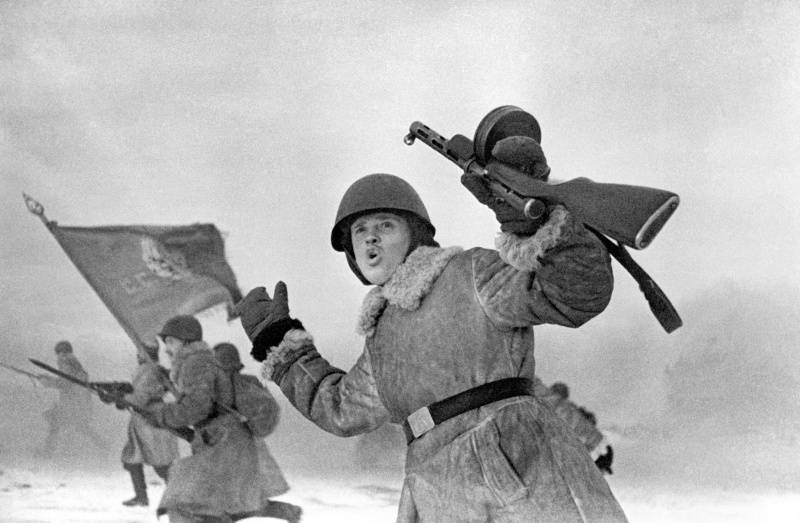
Soviet soldiers in the attack near Leningrad, during the operation to break the blockade of Leningrad. Photo source: http://waralbum.ru/
The command of the Leningrad and Volkhov fronts of 27 in December 1942 was asked to Stalin to postpone the beginning of the offensive on January 10 - 12. They attributed this proposal to extremely unfavorable weather conditions, which led to a prolonged thaw and, in this connection, to the insufficient stability of the ice cover on the Neva and the poor swamp traffic.
In early January, 1943 a joint meeting of the military councils of the Leningrad and Volkhov fronts was held. It clarified the issues of interaction of the front forces in the operation, the simultaneous occupation of the initial position, the beginning of artillery and aviation training, the attack time of the infantry and tanks, the conditional line for the meeting of the front forces - Workers settlements No. 2 and 6, etc. It was also agreed that if one of the fronts, having reached the designated line, does not meet the troops of another front, they will continue the offensive until the actual meeting.
Before the start of the operation, 10 on January 1943, General of the Army G.K. Zhukov, to see if everything is done for the success of the operation. Zhukov familiarized himself with the situation in the 2 shock and 8 armies. On his instructions, some deficiencies were eliminated. On the night of January 11, the troops occupied the initial position.
B. V. Kotik, N. M. Kutuzov, V. I. Seleznev, L. V. Kabachek, Yu. A. Garikov, K. G. Molteninov, F. V. Savostyanov. Diorama Museum-Reserve "Breaking the Siege of Leningrad", dedicated to a turning point in stories of Leningrad defense - operations “Iskra” (Kirovsk, Kirovsky district, Leningrad region)
To be continued ...
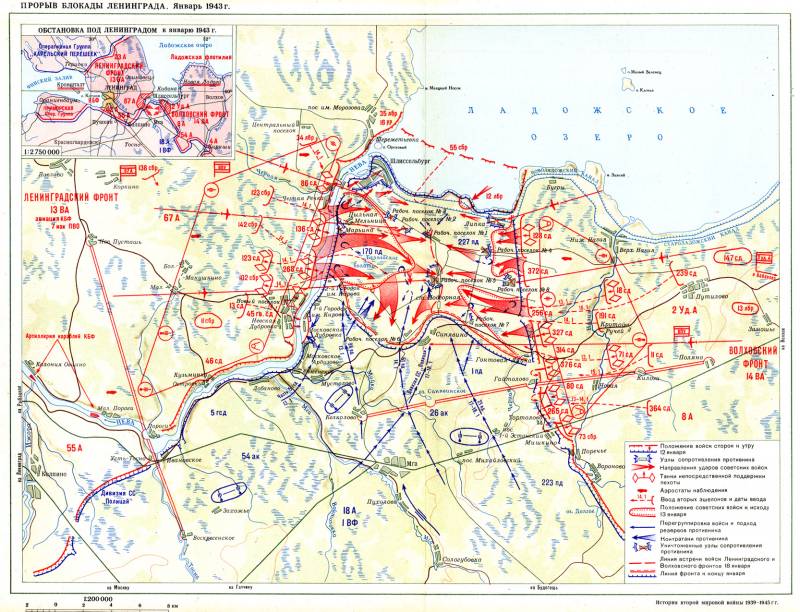
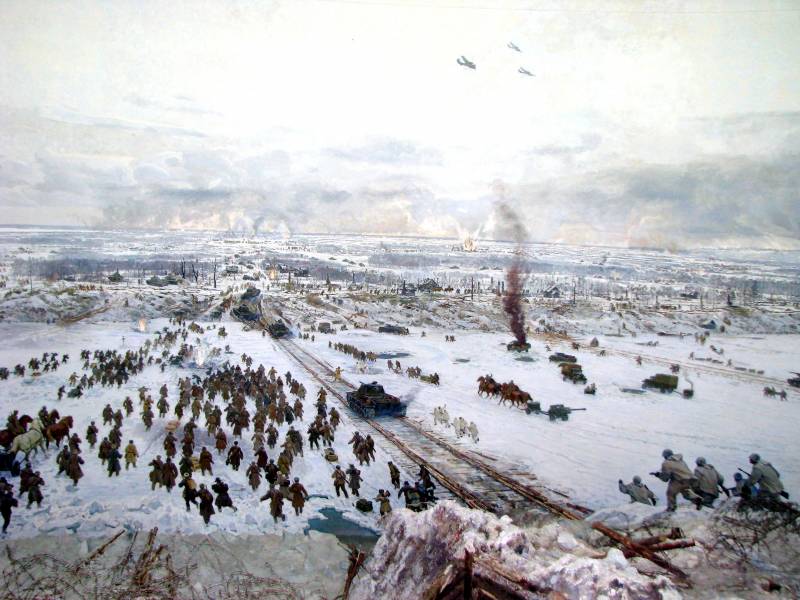
Information